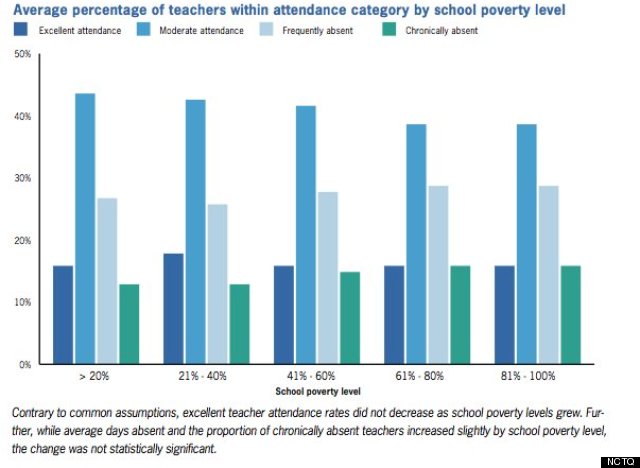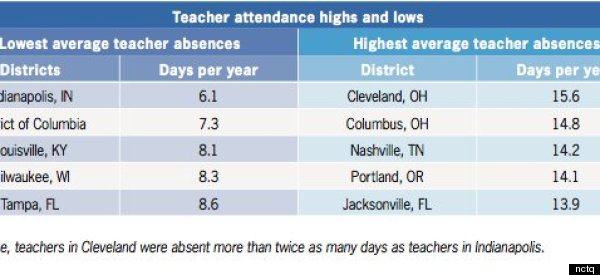Alarming Number Of Urban Teachers Are 'Chronically Absent'
Political battles over teaching in the last decade have focused on complexities of pensions, evaluations and standardized testing, often ignoring a basic but critical issue: Attendance.
Teachers in the nation's 40 largest school districts came to school 94 percent of the time in the 2012-2013 school year, according to the report released Tuesday by the National Council on Teacher Quality, a think tank that advocates tougher teacher evaluations. "Like clockwork," said Nancy Waymack, the group's managing director of district policy. On average, the urban teachers missed about 11 school days out of 186, and used slightly less than their allotment of short-term leave.
But the National Council on Teacher Quality classifies 16 percent of teachers in those cities as "chronically absent," meaning they missed 18 or more days per school year. Together, chronically absent teachers accounted for one-third of all teacher absences. Districts with formal policies designed to discourage teachers from missing class "do not appear to have better attendance rates than those without such policies," the report concludes.

The Washington-based National Council on Teacher Quality fueled many of the ongoing teacher evaluation battles, producing reports urging states to include test scores in teacher evaluations. The group, funded by philanthropists backing the so-called education reform movement, has also tried to shake up education schools byranking them and evaluating their curricula.
As the group collected information on teaching quality, it presented findings to individual school districts. Year after year, Waymack said, district officials expressed surprise with teacher attendance numbers -- an area her team initially thought would be familiar to administrators.
"It occurred to us that teacher attendance could be a very easy win to increase teacher quality. Regardless of how effective a teacher is, it doesn't matter if they're not in a classroom," Waymack said. "There's a substantial cost both academic and financial to absences when they're larger than they need to be."
The study found that the 40 urban districts spent about $424 million on substitute teachers in 2012-2013. Of those districts, Cleveland and Columbus in Ohio, and Nashville in Tennessee, had the largest number of average days absent. Louisville, Ky., Washington, D.C., and Indianapolis had the fewest. In 11 districts, teachers had more absences than the number of short-term leave days offered by the district. The study speculates that those teachers took unpaid leave, or used those days for authorized professional development activities.

To minimize absences, the study suggests changing school culture by requiring teachers to call principals to report absences rather than using an online absence Alarming Number Of Urban Teachers Are 'Chronically Absent':

